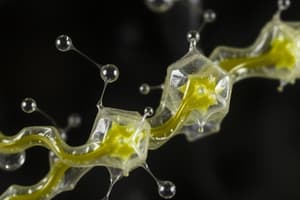Podcast
Questions and Answers
What is the primary purpose of a balanced diet?
What is the primary purpose of a balanced diet?
- To ensure adequate energy for physical activities
- To provide all necessary nutrients for the body (correct)
- To eliminate all forms of fat from the diet
- To limit protein intake to a minimum
Which nutrient deficiency might lead to weakened bones and fractures?
Which nutrient deficiency might lead to weakened bones and fractures?
- Iron
- Fibre
- Calcium (correct)
- Vitamin C
What is the function of proteins in the diet?
What is the function of proteins in the diet?
- Generating immediate energy
- Regulating body temperature
- Facilitating digestion
- Building and repairing tissues (correct)
Why might an athlete require more nutrients than a sedentary office worker?
Why might an athlete require more nutrients than a sedentary office worker?
What is the purpose of the tests for starch and reducing sugars?
What is the purpose of the tests for starch and reducing sugars?
What is the role of digestive enzymes in the body?
What is the role of digestive enzymes in the body?
Which of the following factors can affect enzyme activity?
Which of the following factors can affect enzyme activity?
What does it mean for an enzyme to be 'denatured'?
What does it mean for an enzyme to be 'denatured'?
Where is amylase produced in the body?
Where is amylase produced in the body?
What is the primary function of respiration in cells?
What is the primary function of respiration in cells?
Flashcards are hidden until you start studying
Study Notes
Balanced Diet
- A balanced diet includes the correct proportions of nutrients to meet your daily needs
- Nutrients help your body function properly
- There are six different food groups: carbohydrates, protein, fat, vitamins, minerals, and fiber
- Carbohydrates provide energy for the body
- Protein is essential for growth and repair of cells
- Fat is also a source of energy
- Vitamins and minerals help regulate bodily processes
- Fiber helps with digestion
- Too much or too little of certain nutrients can lead to health problems
Nutrient Needs
- The amount of each nutrient a person needs depends on their age, gender, level of activity, and overall health
- Athletes might require more energy than office workers
- A person with a specific condition may need to adjust their diet
- Iron is essential for red blood cell production
- Calcium is needed for strong bones and teeth
- Vitamin C is important for the immune system
Food Tests
- Food tests are used to identify the presence of specific types of nutrients in food
- The iodine test detects starch
- The biuret test identifies protein
- The Benedict’s test identifies reducing sugars
- The emulsion test detects fats
Digestive System
- The digestive system breaks down food into smaller molecules that can be absorbed into the bloodstream
- The main organs in the digestive system are the mouth, esophagus, stomach, small intestine, and large intestine
- Food is chewed and mixed with saliva in the mouth
- The esophagus carries food to the stomach
- The stomach mixes food with gastric juices
- The small intestine absorbs digested nutrients
- The large intestine absorbs water
- Digestive enzymes help break down food, speeding up chemical reactions
Enzymes
- Enzymes are biological catalysts that speed up chemical reactions in the body
- They have a specific shape and active site that binds to a specific substance (substrate)
- Enzymes are affected by temperature and pH
- The optimal temperature for enzyme activity is usually around 37°C
- Each enzyme works best at a certain pH, outside of this range, the enzyme activity decreases
- Denaturation is when an enzyme's shape changes and loses its function
Amylase Experiment
- Amylase is an enzyme that breaks down starch into simpler sugars
- Amylase is produced in the salivary glands and the pancreas
- Experiments with amylase help understand the factors affecting enzyme activity
- For example, measuring the time it takes for starch to break down at different temperatures can show the effect of temperature on enzyme activity
Respiration
- Respiration is a process that releases energy from food
- Takes place in the mitochondria of cells
- Glucose and oxygen are the reactants in respiration
- The products of respiration are carbon dioxide, water, and energy
- The energy released from respiration is used by the body for various activities, such as muscle contraction and growth
Studying That Suits You
Use AI to generate personalized quizzes and flashcards to suit your learning preferences.




